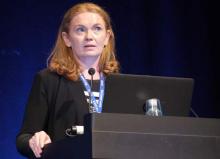STOCKHOLM – The lipid-lowering drug alirocumab significantly lowered low-density lipoprotein cholesterol level to a similar extent in people with diabetes mellitus as in those without diabetes, based on a subanalysis of data from the ODYSSEY Long-Term study.
The calculated change in low-density lipoprotein cholesterol from baseline to 24 weeks was –60.1% with alirocumab vs. –0.9% with placebo, for an overall difference of –59.2% in those with diabetes. By comparison, the corresponding mean changes in LDL cholesterol were –61.5% and –1.8% (a difference of –59.7%) in nondiabetic individuals.
Improvements in other parameters – including triglycerides, high-density lipoprotein cholesterol, and lipoprotein(a) (Lp[a]) – were also similar in individuals with and without diabetes.
“The ODYSSEY Long-Term study is the longest study in the ODYSSEY phase III program,” said study investigator Dr. Helen Colhoun of the University of Dundee (Scotland). The primary endpoint was assessed at 24 weeks, but the trial ran for a further 54 weeks to gather as much lipid and general safety data as possible, she explained at the annual meeting of the European Association for the Study of Diabetes.
Alirocumab (Praulent) is a fully human monoclonal antibody that binds PCSK9 (proprotein convertase subtilisin/kexin type 9) that was recently approved by the Food and Drug Administration for use as an adjunct to diet and maximally tolerated statin therapy in people with heterozygous familial hypercholesterolemia or clinical atherosclerotic cardiovascular disease who need additional LDL-cholesterol lowering.
The main results of the ODYSSEY Long-Term study were published in the New England Journal of Medicine in April (2015;372:1489-99 doi: 10.1056/NEJMoa1501031) and showed a –62% difference (P less than .001) in the mean percentage change from baseline in calculated LDL cholesterol between the alirocumab and placebo groups at 24 weeks. The difference remained consistent over the 78 weeks of follow-up.
Overall, the study included 2,341 individuals at high risk for cardiovascular disease with an LDL cholesterol level of more than 70 mg/dL despite being treated with maximally tolerated doses of statins with or without additional lipid-lowering therapy. Of these, just over one third of the population (35.7%, n = 838) had diabetes. Patients in the trial were randomized 2:1 to receive either alirocumab 150 mg or matching placebo as a 1-mL injection once every 2 weeks.
The present analysis looked at the long-term efficacy and safety of alirocumab in the diabetic subpopulation. Baseline demographic and lipid characteristics of the 838 patients with diabetes were broadly similar to the 1,503 patients in the trial who did not have diabetes, with mean ages of 61 and 60 years. Dr. Colhoun pointed out that virtually all patients (999; 100%) were taking a background statin, and well over one-third of those with diabetes and half of those without were taking a high-dose statin. Approximately 26% of the diabetic population were receiving insulin. Diabetic patients had slightly lower LDL cholesterol and higher triglycerides than their nondiabetic counterparts at baseline, as would be expected, she added.
Similarly high proportions of patients with (78.4% vs. 10.6%, P less than .0001) and without (79.7% vs. 6.6%, P less than .0001) diabetes who were treated with alirocumab vs. placebo achieved a target LDL cholesterol level of less than 70 mg/dL at 24 weeks.
Alirocumab treatment was associated with a 3.5% increase in HDL cholesterol in patients with diabetes and a 5.6% increase in those without, and triglycerides were reduced by a respective –18.5% and –16.7%. The adjusted mean differences in Lp(a) were –27.2% and –24.9%, an effect not seen with statins, Dr. Colhoun said.
“Overall the safety profile was excellent with this new class of drug, and there weren’t any major surprises or differences in safety profile between those with diabetes receiving alirocumab and those without diabetes,” she noted. Less than 10% of adverse events led to treatment discontinuation, at 8.3% vs. 5.0% for active and placebo treatment in the diabetic group and 6.5% vs. 6.3% in those without diabetes.
Data on the risk for new-onset or worsening diabetes in the ODYSSEY program will be presented at the scientific sessions of the American Heart Association in November, Dr. Colhoun said, giving a sneak peak of the findings from the ODYSSEY Long-Term study that indicated that there was no increased risk for either. Rates of new-onset diabetes were 1.8% in the alirocumab-treated group and 2% in the placebo group and of worsening diabetes, were 12.9% and 13.6%, respectively.
Treatment-emergent major cardiovascular events (MACE) were evaluated as a safety parameter in a post hoc analysis. Although not a main endpoint of the study, the results showed a lower rate of MACE in the overall population with alirocumab than placebo treatment (1.7% vs. 3.3%; hazard ratio, 0.52; 95% confidence interval, 0.31-0.90) and in both diabetic (2.5% vs. 4.3%; HR, 0.58; 95% CI, 0.27-1.25) and nondiabetic subjects (1.3% vs. 2.8%; HR, 0.47; 95% CI, 0.22-1.0). “This is reassuring, but it is not by any means definitive evidence of a [cardiovascular disease] benefit,” Dr. Colhoun stressed.


